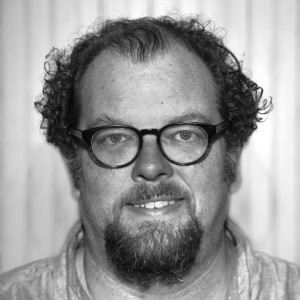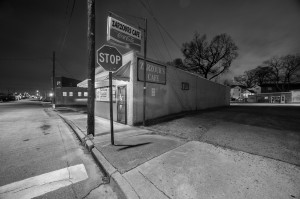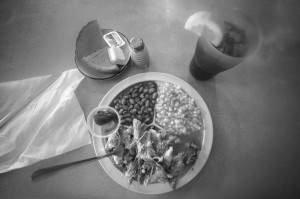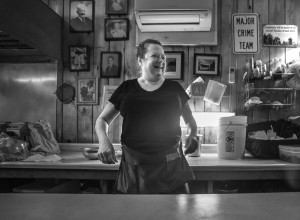The following interview was done with Bradley Shelton just prior to his show “Please Seat Yourself”at The Northshore Gallery of Contemporary Art. This photographic essay explores the world of Chattanooga’s Zarzour’s Cafe. A tradition in Chattanooga, Zarzour’s Cafe first opened for business in 1918, and has been in continuous operation at the same location and run by the same family ever since. The show closed at the end of September, 2014.
See more of Bradley’s art at: Bradley Shelton
For interviews with other photographers see: Art Nomad
You’re a practicing architect here in Chattanooga. How did you also become a photographer?
Back in 1996 I went to Auburn University and majored in architecture. During my sophomore year I took part in the Rural Studio program. That’s a program that sends students out into the community, in my case Hale County, one of the poorest counties in Alabama. In the Rural Studio program the students design and build community based projects. The program required us to read the James Agee and Walker Evans book set in Hale County, Let Us Now Praise Famous Men, and I loved the Walker Evans photos. When I returned to Auburn, I had an elective I could take. So a buddy and I decided that we would take a photography class. We assumed it would be a breeze and take up little time, since we were focused on our studio work. Turned out it we were wrong; it turned out to be a lot of work — and fun. We shot in black & white using T-Max, a high contrast film made by Kodak. The class was based on the zone system and the goal was to teach us the basics of how to plan, to take, and to develop a photograph. As we matured as photographers, our professor began to teach us the more mental side, like how to pre-visualize a shot. Michael Robinson, an Urban Planning professor, taught this photography course at night. It was during that course and the long nights in the darkroom that I fell in love with the process and complexities of making a photograph. I got a grasp on how to handle the tonalities, and I soon began to pre-visualize how I wanted a photo to look before I snapped the shot.
What equipment did you use on “Please Seat Yourself”?
My camera and equipment are all Nikon, and the camera I use is a D-700. But I don’t get too hung up on equipment. As they say, the best camera is the one you have with you. There are several images in the show I took with my cell phone. You can get a great photo with a cheap camera, and a crappy one with $10,000 state of the art equipment. In the end, it’s about the ability of the photographer and his artistic vision that make all the difference. I not saying that using good equipment isn’t important–it’s a huge part of what I do–it’s just not the essential part.
Do you still use the methods you were taught in film even though you’ve moved to digital?
I definitely continue to rely on the zone system — the 12 zones of gradiation from solid black to solid white. Of course, digital photography has changed the way you pre-visualize. With film you really had to plan carefully in the camera: “the sky is going to be in zone 9 and the tree is going to be in zone 2”, that sort of thing. You still have to capture the right exposure, but the majority of the tonal decisions are made in post-processing. Shooting digitally frees you to focus more on composition, because with the proper exposure, the tonalities can be set during the development process. This equates to less time behind the camera, more time developing in Photoshop.
So today Photoshop is the equivalent of the dark room experience?
Yes, it’s very similar in a lot of ways. Some of the terminology is different, but from an artistic standpoint it’s essentially the same process. I think it was Ansel Adams who said, that when you click the shutter, it’s about capturing information. Art is what happens in the dark room as you work with that information. If you think of it that way, then digital and film are very similar. Of course, with sheet film you have more limited chances when shooting. A roll of 35mm film might give you only 36 shots, and I can take 1,000 in an afternoon with a digital camera. Adams also said, photographs are made, not taken. Snapping the shutter is only half of the process of making a photograph. You’re trying to capture all the information you can,in the camera. Whether it’s in the dark room or on the computer, if you have the information, you can make the image you want.
What film editing programs do you use?
I use Photoshop and Lightroom. Sometimes I use Apple Aperture for certain things, but mostly it’s the first two.
Why do you favor black & white?
I think my interest in black & white comes from my study of form—that’s what draws me to architecture. There’s something about black & white that seems to abstract form, I think, more so than color images. Black & white kind of distills everything.
So you visualize and shoot in black & white?
I typically visualize and develop in black & white, but I shoot in color.
Why?
Most digital cameras have a black and white setting, but much of the tonal information is lost so I never use it. With color there are 256 variations and when shooting in the camera’s black and white mode it will only capture those 12 or so gray tones. So the camera is interpolating how to condense 256 colors into 12 shades of gray [laughs]. That would make and interesting book title. No, I want control over the tonality of the image and I want all the information possible. I want to control that conversion to black and white.
Are you thinking of the 12 zone system when you set up a shot, even if you’re shooting in color?
Sure. There’s an image in the show I call “Pork and Dressing”. It’s an image of a plate of food I was about to start chowing down on, but I saw a beam of light hitting the plate, making it lighter than everything around it. So I thought, ‘I really need a photo of that!’ Now because of the way the light was hitting the plate, it needed to be in an upper zone, brighter than anything else. The surrounding area would be in a lower darker zone. So you see, the zone system is a way to visual the structure of the photo as well as something to use later in Photoshop. It helps you understand and analyze what you’re seeing and where you’re trying to get to.
Well, you certainly get blacks and grays that are rich and compelling. I liked that when I first saw your series, “Pig Roast”. How do you get that kind of tonality?
You have to expose the photo with that in mind. We’ve talked some about the differences between film and digital, but another of those differences is that in film you expose for your darks, trying to keep as much detail in them as you can. If you get those right, you can handle the highlights okay. With digital, it’s the opposite. You expose to give detail in the highlights. If you don’t, they will wash out and you lose that information.
Now, in both “Pig Roast” and “Please Seat Yourself”, the theme was about people and everyday things. Both required a lower key approach tonally—a deeper, richer look. For me, low key imagery and those subjects go together. So that was driving my desire for rich dark tones. Still, there are exceptions in the show, like ‘Pork and Dressing’, where the image is in a higher key. I felt that particular situation warranted an overall lighter tonality. Still, at the point where I’m taking the picture the technical aspect is about getting the exposure right. This allows me to focus on the composition of the subject. I think what I’m saying is that I want to make the shot in camera as close as possible to the finished image.
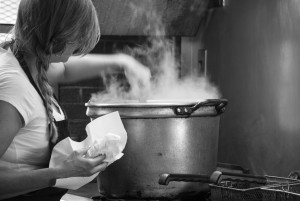
Halfway Done
That surprises me. I just assumed you cropped your way into the wonderful compositions your photos have.
No, that’s not my approach. There are occasions when I see something in the development stage that surprises me—something I didn’t notice when shooting and cropping is necessary. Sometimes an image is made better by a healthy crop, but I don’t enter into the process with the mindset that I can just crop later to get a good image. Most of the time the final composition is what comes out of the camera.
Tell me about the experience of doing this project on Zarzour’s Cafe. It was a long term commitment, which is quite different than, say, doing an afternoon shoot studying the changing shadows on an old building.
Yeah, it was long term. I worked on “Please Seat Yourself” for three years—I thought it would take six months (laughs). Most of the images in the show come from my last two years of shooting. I’ve done the kind of afternoon shoot you’re talking about, but with “Pig Roast” and “Please Seat Yourself”, the idea of the story was just part of the subject. With “Pig Roast”, we were having ayearly pig roast, and after taking pictures for several years, a story with a timeline emerged. The same thing happened with Zarzour’s, but with an added dimension. I hadn’t worked on that series long before I thought, these are great people! They are real salt of the earth kind of folks, and it is their story that drove the project. It made me want to invest the time and effort to make them proud. I got to know them as people and as friends. I came to find that being there, just talking with them and showing them some of the pictures, had another dividend. I became in a way invisible, well, maybe not invisible, but everyone was comfortable with me shooting and it allowed an honest view of things. I gained an acceptance and an ease of access that made the story deeper.
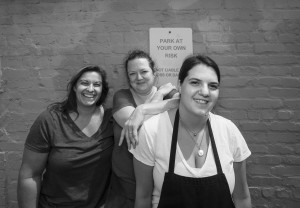
The Crew
Why Zarzour’s Café? How did you decide on that subject?
The photographing ofthe yearly pig roast led me to the idea of working on a series done over time. I wanted to tell a story about a place through images. To be special it hadto gain deeper insights than you could hope for on an afternoon shoot. So from there it was not too big a step to Zarzour’s. I’ve been eating there since I moved to Chattanooga, eight years ago. Chattanooga is lucky to have great places like Zarzour’s Cafe, or Nikki’s Drive-in, or Griffith’s Hotdogs. Places that are long established and have incredible character. So many of those places are gone, driven out by the big chains, and that’s sad. You don’t go in a chain burger joint and chat with the waitress about how her kid did in his baseball game. In places like Zarzour’s, you become part of an extended family. So anyway, I’d been eating there for a while and one day I walked up to Shannon, who now runs Zarzour’s, and showed her my pig roast photos and said, “You mind if I take some pictures around here?” and she said, “Sure.” So every couple of weeks I’d come in and take some pictures. If I got one I liked, I’d print it and show it around to the folks there. I got to know everyone and it just felt more and more natural. One morning, I met Mary at 7:00am and photographed her as she prepared food for the day. It reminded me of my grandmother’s kitchen, how she prepared food, and that’s kind of close to my heart. So I guess that’s how it happened. I showed up one day and said, “I want a roast beef plate and I want to take some pictures.” They are great people and damn if they didn’t let me do it [laughs].
To what extent were you shooting to a prior mental narrative, one you carried with you through the door, and to what extent did your narrative just evolve from what you were seeing and photographing as you tried to make sense of it?
The only plan I had when I started was a notion that it would be great to document aesthetically what the place looked like. I mean allthe pictures on the wall are their family and close friends. Hell, Charles Zarzour’s immigration papers are hanging on the wall. Amazing! The imagery of the space is what attracted me to take the first pictures. Then from that, the urge to tell the daily story of the place emerged. What makes Zarzour’s is that particular family. They’ve run it for four generations, and over time the place has become a portrait of them. But you know, I recently noticed another thing. After three years of taking pictures, I realized you can also read this essay, not onlyas a portrait of the people, but as the story of one day in the life of the restaurant. “Please Seat Yourself” begins with a closed café and ends, after all the activity, the same way. The show could have been entitled, “A Day in the Life of Zarzour’s Café.”
Do you have plans to do additional essays like “Please Seat Yourself” on other local cultural landmarks?
I don’t know as I’ve made that decision yet. I would like to. I think the focus of any project of this nature would be the people involved. Could I do a Barber Shop? There’s potential there. Griffith’s Hotdogs have been around a long time and it has a certain character that is unique in Chattanooga, It’s different from Zarzour’s Café but it’s the same, too. I don’t know what the future holds. I don’t know where the camera will take me. I think whatever I work on next, it’s important to me that there be an element of Chattanooga in there—that the places be in Chattanooga. These places are important to our culture. They have survived. How did they do they do it? I think it has something to do with the people.
Return to Interviews with Artists
